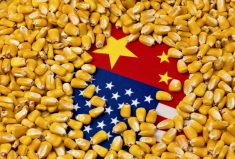Glacier FarmMedia – A major farm lender in the United States forecasts another strong year of Chinese grain and oilseed demand in the new crop year, and that bodes well for prices.
“Predicting with certainty whether China will purchase the same levels of U.S. soybeans, corn and sorghum over the next year as it has done so over the past year is impossible,” CoBank said in a recent report.
“That said, we conclude that China will remain an active buyer of U.S. grain through at least the 2021-22 marketing year based on steady pork production, higher slaughter rates and currency tailwinds.”
Read Also

Dissolving eartags could make pig traceability easier
A dissolving eartag for market hogs, called Clean Trace could reduce processing challenges and enable more individual management of pigs.
Why it matters: China has had significant impact on global feed grains markets, especially soybeans, and an increase in the hog sector could keep up crop prices — but put pressure on pork prices.
China has already contracted 10.7 million tonnes of new crop U.S. corn, or two-thirds of its total anticipated imports from that country. It also bought three million tonnes of new crop soybeans.
“Barring cancellations, these orders lend confidence that U.S. feedgrain exports to China will continue to be strong during the next six months,” said CoBank.
The U.S. Department of Agriculture forecasts that China will slaughter 520 million hogs in 2021. That would be up from the trough of 460 million hogs in 2020 but well below the peak of 735 million in 2014.
The Food and Agricultural Policy Research Institute estimates the slaughter rate will be closer to 630 million head, 21 per cent more than the USDA is forecasting. That would result in a similar bump in Chinese feedgrain demand.
CoBank also noted the Chinese yuan has been appreciating relative to the U.S. dollar since May 2020, enhancing the country’s purchasing power.
“(That) has been an additional tailwind for exports over the past year,” stated the bank.
Arlan Suderman, chief commodities economist for StoneX, agrees that China’s purchases of U.S. corn and soybeans will be robust in 2021-2,2 but he doesn’t think they will be as strong as in 2020-21.
A liquidation in China’s hog herd this spring drove pork prices sharply lower to almost pre-African swine fever levels.
The pig-to-corn price ratio is so low that hog producers are reluctant to restock their herds.
Soybean crush rates are slowing in China, yet soybean meal supplies are rising.
“That suggests that we’re seeing decreased hog feeding,” said Suderman. “We think that will continue until the price relationship improves again, maybe at the end of the year.”
StoneX expects China’s red-hot demand will continue to cool over the next four to six months.
Suderman is forecasting 57.42 million tonnes of U.S. soybean exports to China in 2021-22, down from 61.64 million tonnes this year. He has a similar outlook for corn primarily because China’s wheat crop is of poor quality this year and will displace corn in hog rations.
Imported corn was being shipped directly into the feed market earlier this year, but his contacts in China say it is now being diverted into government reserves.
Suderman forecasts 22 million tonnes of total Chinese corn imports in 2021-22, which is well below the USDA’s 26 million tonne number.
“Those are still good numbers but not as good as what was previously expected,” he said.
Imports of U.S. corn could dip even further if Ukraine has a decent crop or Brazil finally signs a phytosanitary agreement with China.
CoBank is forecasting increased corn and soybean price volatility in 2021-22 due to an “onslaught of mixed weather outlooks” in key production regions of the world.
The unwinding of net long positions by non-commercial players in agricultural commodity markets is also creating price uncertainty.
CoBank said China has already been an opportunistic buyer of new crop U.S. corn and soybeans, purchasing massive volumes when futures prices fall. It anticipates a continuation of that buying pattern in 2021-22.
This article was originally published at The Western Producer.















